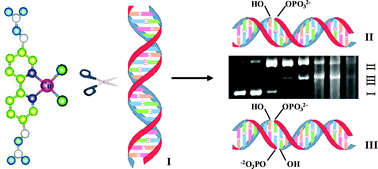Double-strand DNA cleavage by copper complexes of 2,2′-dipyridyl with guanidinium/ammonium pendants†
Abstract
Two ligands with guanidinium/

* Corresponding authors
a
MOE Key Laboratory of Bioinorganic and Synthetic Chemistry, School of Chemistry and Chemical Engineering, Sun Yat-Sen University, Guangzhou, China
E-mail:
cesmzw@mail.sysu.edu.cn
Fax: +86 20 8411 2245
Tel: +86 20 8411 3788
b Department of Chemistry, the University of Hong Kong, Pokfulam Road, Hong Kong, China
Two ligands with guanidinium/

 Please wait while we load your content...
Something went wrong. Try again?
Please wait while we load your content...
Something went wrong. Try again?
J. He, P. Hu, Y. Wang, M. Tong, H. Sun, Z. Mao and L. Ji, Dalton Trans., 2008, 3207 DOI: 10.1039/B801549J
To request permission to reproduce material from this article, please go to the Copyright Clearance Center request page.
If you are an author contributing to an RSC publication, you do not need to request permission provided correct acknowledgement is given.
If you are the author of this article, you do not need to request permission to reproduce figures and diagrams provided correct acknowledgement is given. If you want to reproduce the whole article in a third-party publication (excluding your thesis/dissertation for which permission is not required) please go to the Copyright Clearance Center request page.
Read more about how to correctly acknowledge RSC content.
 Fetching data from CrossRef.
Fetching data from CrossRef.
This may take some time to load.
Loading related content
